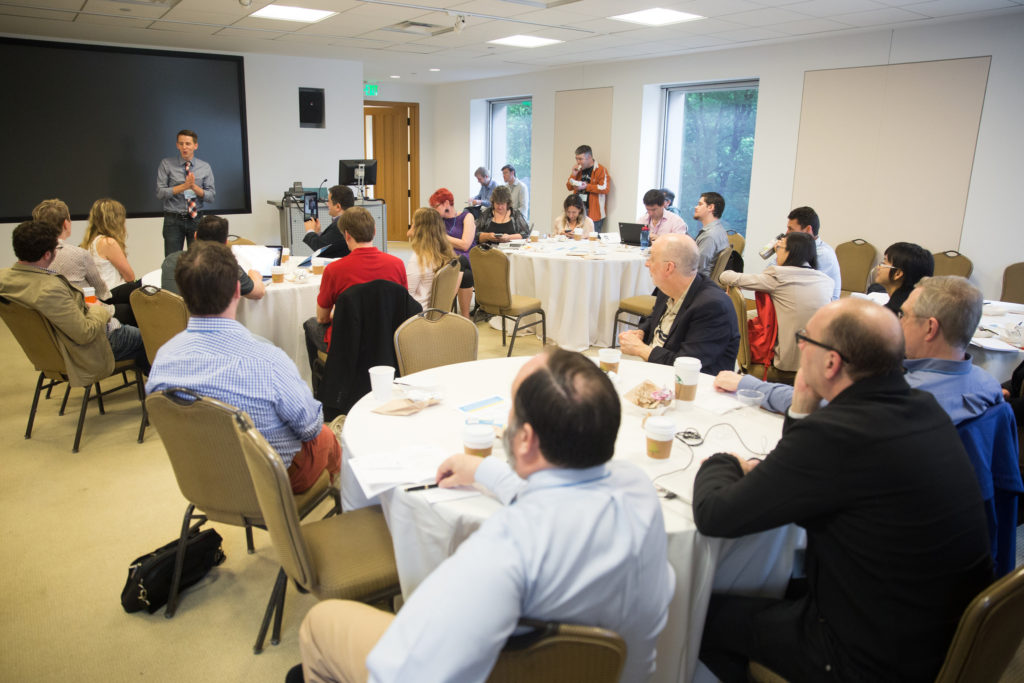April 18, 2015 | Research
ISOJ academics debate journalism within the age of digital disruption
Journalism researchers struggled to find the relationship between technology, the public, and news writers at the International Symposium on Online Journalism (ISOJ) on Saturday.
Specifically, researchers tackled the question of defining what journalists know in a profession of constant change.
Christopher Anderson, an assistant professor at CUNY, College of Staten Island, was optimistic about growing a consistent body of research on data journalism. His research focuses on journalists trying to find who their audience is in order to strengthen democratic discourse.
He emphasized the value of breaking ground in a digital age, pointing out, “All these projects matter because we are reaching a point where we are ready to step back and synthesize findings.”

Anderson said that although technology is constantly changing journalism, journalists should push back against a fatalistic agnosticism in identifying their target audience and generating conversation.
“[You hear often that] things are changing so fast that we can’t know anything. But at this point we should really say, ‘Hey! There are some things we know!’”
Seth Lewis, an assistant professor at the University of Minnesota, also focused on technology, asking the audience whether looking at individual Twitter comments or an entire conversation bore more fruit in research. He noted an increase in communication in conversations between journalists since 2012 on Twitter. However, he cautioned that such interactions do not always extend to readership.
Carrie Brown, director of social journalism at CUNY Graduate School of Journalism, detailed her project on newsroom culture. She pointed to what she saw as the disconnect between technological improvements and newsroom priorities and methods. Using The Christian Science Monitor as an example, Brown highlighted the tension of increased online viewership at the paper in tension with a continuing priority on the printed product.
Jonathan Groves, a frequent co-author with Brown and an associate professor from Drury University, also noted the tensions between news reporters and religiously-based funding structures and management in the coverage of stories involving material that the Church of Christian Science considers immoral.
Alfred Hermida, an associate professor at the University of British Columbia’s Graduate School of Journalism, asked what values play a part in a journalist’s interest in online journalism and how that affects his or her use of technology.
The audience’s reaction showed signs of both frustration and anticipation. One audience member recalled a report in 2014 about The New York Times’ struggles shifting in the digital age, but did not touch on the issue of The Times’ journalistic content.
Audience members offered a slew of suggestions: Covering race and data journalism, looking to digital news agencies like Vox Media as potential models, and interdisciplinary utilization of fields like sociology, anthropology, and political science.

Regina Lawrence, a journalism professor at the Moody College of Communication at the University of Texas at Austin who has political science expertise, agreed with these suggestions, saying that many times data journalism research can seem like a decontextualized “cottage industry.” She showed skepticism that journalists and readers could find deep political coverage on social media such as Facebook or in local news stations.
Lewis summed up the challenges for studying this emerging field: “I agree that these [data journalism] studies should be maturing, but it’s becoming harder to quantify this phenomenon because it’s so fragmented. It may be valid, but is it meaningful?”
This 16th annual edition of ISOJ is being livestreamed in English here, and in Spanish here.

